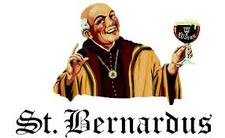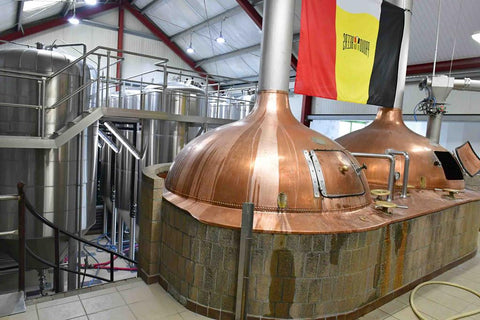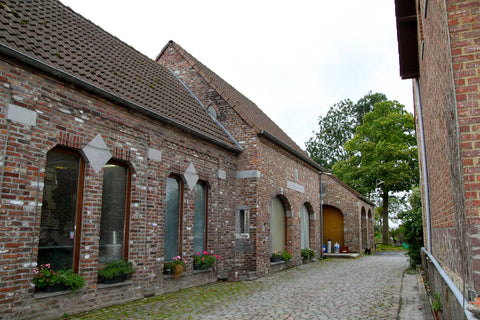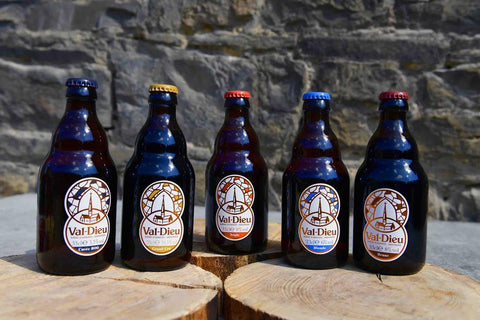- No products in the cart.
Brouwerij St. Bernardus

The Beginning – It's no coincidence that the St. Bernardus brewery of Watou is to be found on the street called 'Trappistenweg'. The brewery’s name, as well as the character of its beer, are very much grounded in the Trappist tradition.
And less than ten kilometres away, just across the border with France, you'll find the reason for the connection – in the shape of the Trappist abbey of Mont des Cats (Katsberg).
It turns out that St. Bernardus was set up, in 1904, as a refuge for monks coming from that hill-top monastery. Its name actually refers to Mont des Cats's church, St. Bernardus, which is sited right on top of the French Flanders' hill.
The monks from the Mont des Cats monastery even sought shelter in this Belgian farm refuge, during the First World War.
But in 1934, once the Mont des Cats abbey was reconstructed following that war, the Watou refuge of St. Bernardus shut its doors, to the spiritual path at least. Instead, the site became a home to a noted cheese-maker, Evarist Deconinck, who started a cheese dairy on its grounds. There the story might have ended, but Evarist was rather good friends with the then abbot of Sint-Sixus abbey, in Westvleteren.
After the Second World War, the abbot asked him if he would like to brew and market the monks' Trappist beer.
While the monks had been selling their own beer throughout the region, they felt that these commercial-scale endeavours were too much of a distraction from their religious activities. Evarist was pretty keen on the proposal, and negotiated a 30-year licence with the Trappist abbey. The monks would use the revenue from these beer sales to renovate their abbey, while Westvleteren’s brewmaster, Mathieu Szafranski, joined the Deconinck brothers – Evarist and Antoine – in partnership. So that's how St. Bernardus came to start the brewing – and promoting – of the Westvleteren Trappist beer, based on its original recipe and using Westvleteren’s own yeast.
At the same time, the monks of Westvleteren continued to brew for their own needs – and to supply the In De Vrede café, plus two other local cafés in the village.
St. Bernardus initially produced four Trappist beers: Sint-Sixtus 4, 6, 8 and the Abt 12. Before long, the familiar logo would make its appearance, featuring a monk holding a glass and with a different background colour for each type of beer.
Throughout the years, the label itself has carried several different names, though: initially 'Trappist Westvleteren', then 'Sint-Sixtus', followed by 'Sint-Sixtus & St. Bernardus', and, from 1992 onwards, 'St. Bernardus' only. Until 1959, the morning was reserved for brewing and the afternoon for cheese-making. That ultimate synergy between beer and cheese stopped when Belgomilk acquired the cheese dairy. The building that used to house it has now been converted to a B&B, a convenient beer-lover's bolthole, right next to the brewery.

Then, in the year 1962, Bernadette Deconinck, who was Evarist’s daughter, married engineer Guy Claes.
At that time, the licence agreement with Westvleteren was extended for a further thirty years, and so Trappist's beers continued to be brewed by St. Bernardus until 1992. But a change was in the offing, long before that date. In 1985, the Sint-Sixtus abbey of Westvleteren inaugurated a new brewing hall. Seven years on, and the monks were once again brewing their own Trappist beer, within the abbey walls – which is as just as it should be, for a recognised authentic Trappist beer.
But obviously this change threatened the future of the St. Bernardus brewery. Innovation was called for. When the licence agreement with Westvleteren expired, the St. Bernardus tripel was successfully launched.
Now St. Bernardus offers its own range of abbey beers, ones that many consider to be genuine heirs ofthe Westvleteren Trappist beers. In addition to these abbey beers, there are the St. Bernardus Wit, St. Bernardus Christmas Ale, the Grottenbier and the Watou Tripel, all of which are brewed on-site.
These are very popular outside Belgium. Around half of the volume produced (33,000 hl) is destined for export, these days. Change has remained in the air at St. Bernardus for the last 2 decades. The brewery was purchased in 1998 by West Flemish investor, Hans Depypere. And while Guy Claus continued to play an active role in the brewery, he bowed out in 2007.
September 2014 also saw the brewing capacity increase to 80,000hl, when a new brewing hall was taken into commission.
The Brewing

St. Bernardus is renowned for the superior quality of its beer. It's not without good cause that these abbey beers are mentioned in the same breath as the world-famous Westvleteren Trappist beers – they are both brewed using abbey’s original recipe, after all.
Moreover, to this day, the main fermentation of all of its beers (including the witbier) is done on the basis of the original Westvleteren house yeast.
In contrast, Sint-Sixtus abbey is now using the Westmalle yeast. St. Bernardus has found that its yeast strain is extremely effective when it comes to converting sugars, leaving with very little sugar residue. It also gives the abbey's beers their fruity character, with no alcohol aroma.
Over the years, a number of beers, with a reputation for rock-solid quality, have seen the light. The successful Christmas Ale was added recently, and the brewery is expanding its current range, tying in with its plans to increase capacity. St. Bernardus is currently brewing six days out of seven, with a total of seven to ten brews per week. Right up to the present day, brewing has been done the traditional way, using copper kettles and locally-farmed hop varieties (Kent Golding aroma hops, Hallertau Magnum bittering hops). In fact, some of these are still farmed in the hop field next to the brewery.
When the old-school kettles recently gave way to a new-style stainless-steel brewing hall, the transition was monitored very carefully.
St. Bernardus we're keen to avoid any differences in taste. The old brewing hall itself, dating from the 1960s, is no longer used. Instead, it is now a part of an upgraded brewery tour instead. The St. Bernardus beers' taste is very much framed by the water the abbey uses. It is pumped up from 120m underground, where it has accumulated after permeating many layers of solid stone and clay.
It's thought that this mineral water made it's journey over centuries, seeping slowly into the reservoirs. It makes for water that is as remarkable for its salty taste (which requires a measure of desalination before use) as it is for its mild character.
The Brewers

Hans Depypere, the owner of the brewery, actually used to work in security management, in the USA and elsewhere. The quality of the Sint Bernardus beers and their excellent reputation convinced him that taking over the brewery was a viable proposition. In doing so, Hans did not leave anything to chance. He had a number of crates of Sint Bernardus stored in his cellar.
The enthusiastic reactions of his friends and acquaintances after tasting this brew spoke volumes. This liquid heritage just had to be preserved. ‘A good beer does not need promotion’, is the motto of this down-to-earth West Flemish man.
If the beer is as good as they say, it will sell itself. This brewer will not get above himself or shout about the quality of his beer from the rooftops. In the end, it is the consumer who decides.
The brewer is following the tradition of mild beers, where the yeast is a main factor in determining the taste and hops are used to support this. In co-operation with his friend Rudy Ghekiere, site manager for Rodenbach, Hans Depypere founded the Kazematten microbrewery in the historic casemats, or defense works, in the town of Ypres.
The company is managed by Rudy’s son Maarten and Hans’ daughter Julie, and has its headquarters at the Sint-Bernardus brewery. De Kazematten is now brewing the Grottenbier (6.5% ABV) on behalf of Sint-Bernardus as well as the blonde Wipers Times (6.2% ABV).
The Beers
The Visit

One of the great advantages of visiting St. Bernardus is that, unlike with the Trappists, you have the opportunity to peek behind the walls. Just don't expect a fully-fledged abbey experience – this is very much a functional and,commercially-orientated brewery.
Organised visits to St. Bernardus include an extensive tour of the brewery and bottling plant, taking about an hour and a half, altogether. A brief movie will introduce you to those time-tested St. Bernardus brewing processes.
The tour ends with a tasting of the St. Bernardus beers in the cosy brewery café ‘In de Gouden Ster’. At this point, participants will also receive a gift pack with a bottle each of St. Bernardus Tripel, Pater, Prior and Abt – and an authentic brewery glass. The brewery shop also sells all kinds of beery merchandise: beer glasses, t-shirts, cycling jerseys, bottle openers and much more.
Brewery visits can be arranged for groups of 15 and over, on request. Organised tours for individual visitors are held every Friday afternoon.
If you'd like to make the most of your time in Watou, the former cheese workshop attached to the brewery has now been converted into a comfortable Bed & Breakfast, with room for 26 guests.
The Location

The St. Bernardus brewery is but a bow’s shot from the French border, in the far west of the Westhoek. The region is usually called ‘de schreve’, or 'on the cusp’ between the two countries. Characteristic of this region are its cozy village cafés, or 'estaminets', which often have surprising names, with interiors to match.
Watou itself is a farming village typical of the rural Westhoek. Within Flanders, it is primarily known for its annual arts festival, which takes place in July and August. A number of artists – some of whom are nationally and internationally renowned – set their creative spirits free.
You'll find artworks at the church and churchyard, in and around the town's cafés, and across the surrounding farms. It's an experience best seen rather than described, so if you're there in the summer, go for a walk and discover for yourself.
Several signposted walks have their starting point in the village. The Smouthoukpad trail (8 km) is laid out on both sides of the Franco-belgian border. The Warandepad Watou route (10 km) also follows the border. A slightly more adventurous choice is the Off Way Wandelroute (19 km) which will take you along some quite unexpected detours – this one is also recommended for mountain bikers. The Volkssportroute, or 'popular sports route', is an initiative put together by the Poperinge Tourist Bureau. It takes you to a number of small cafés and estaminets where you can try your hand at traditional Flemish games.
And a long list they are – activities such as horseshoe throwing, 'schieten op de liggende wip' (archery), 'vliegende vogelpik' (darts where the target moves), 'uilebolling' (throwing wooden balls through arches), 'tonspel' (a throwing game with pucks), table skittles and ring throwing.
These days the village of Watou basks in an unruffled rural peacefulness. It's easy to forget that, almost exactly one hundred years ago, Watou and its surroundings was the scene of a globally-resonant catastrophe. The First World War has left its traces everywhere here in the Westhoek.
The many war cemeteries and monuments are silent witnesses to the violence of that first truly global war. For four long years , soldiers were battling from trenches dug deeply into the heavy clay soil of these polders. Hundreds of thousands lost their lives. Visit the In Flanders Fields museum in Ypres to find out more about the 'Great War'.
Getting There & Around

Watou forms part of the community of Poperinge, balanced almost atop the French border. It is around a two-hour drive (146 km) from Brussels. Take the E17 Gent/Kortrijk, followed by the E403 to Ypres, in the direction of Vlamertinge and Poperinge. Then drive onwards to Watou via Sint-Jan-Ter-Biezen.
Public transport will take somewhat longer, with the nearest train station being in Poperinge. From there you'll have to request bus 69, and alight at Watou Markt (stop number 69). Take note, though: this bus doesn't have a fixed timetable.
Cycling is an excellent way to discover the charms of this flat country with its unsullied horizons and endless vistas. It's best to use the existing cycling network. Buy a map at the local tourist office and track along the numbered nodes, or ‘knooppunten’, until you reach your destination.
You will also find some signposted and numbered cycling routes. For example, there are three beer-named cycle routes departing from the St. Bernardus brewery: the St. Bernardus Pater 6 route (21 km), the St Bernardus Prior 8 route (36.8 km) and, longest of all, the St Bernardus Abt 12 route (74 km).
The Abt route provides a splendid tour of the Westhoek, taking in Poperinge (with its Hop Museum, and the famous Talbot Museum), the war cemetery of Lyssenthoek, the De Lovie castle, the Mendinghem Military Cemetery in Proven and – last, but certainly not least – the Sint-Sixtus Abbey in Westvleteren. Here you can taste its semi-mythical Trappist beers at the peaceful In De Vrede abbey tavern, about as close as you can be to its source.
Gastronomy, Food & More Beer

Watou proudly bears the title of ‘beer village’, and not without justification. And around here the hops are freshly harvested, straight from the fields. If you want to find out more about the hop cultivation of the Westhoek region, pay a visit to the Hop Museum in Poperinge.
The museum is housed in the ‘stadsschaal’ building, which held the town's weighing scales. Citizens used to have their hops weighed, approved and stacked here.
The farmers also once dried their hop cones under the farmhouse roof, before filling their jute bags with the dried hops. The museum will show you how life in the area around Poperinge was lived, based as it was on the rhythm of hop farming.
There are still hop fields in the area, including one right next to the St. Bernardus brewery. Hop is not only used as a beer ingredient here.
Hop shoots are a delicacy that can often be found on the menu at the tail-end of winter. The hop farmers will dig up the roots of those plants they are planning to weed out, and transport them to a barn or greenhouse. The resulting shoots will be cut by hand, by no means an easy job. So the restaurants in the area don't have a problem in sourcing their hop sprouts. We recommend Restaurant ‘t Hommelhof, in Watou, if you want to sample some local dishes making good use of hop shoots.
Chef Stefaan Couttenye is, in fact, one of the main beer-cuisine pioneers of Flanders. For many years Stefaan has been using the local beers in the preparation of his recipes and he will serve these same beers to accompany the meal.
The Westhoek area has a rich regional cuisine. Try a slice of Mazarinetaart, a sweet pie with cinnamon, syrup and butter, or a portion of 'potjevleesch' (potted meat). Other regional specialities include 'hennepot', a cold dish in aspic made with chicken, rabbit and veal. Or why not taste a slice of 'hoppepaté', a paté made with hop extract and hop jenever?
More Info
Toerisme Poperinge
Grote Markt 1
B-8970 Poperinge
Tel. +32(0) 57 34 66 76
Website: www.toerismepoperinge.be
Email: toerisme@poperinge.be
Contact

Trappistenweg 23
B-8978 Watou
West Flanders
Belgium
B-8978 Watou
West Flanders
Belgium








